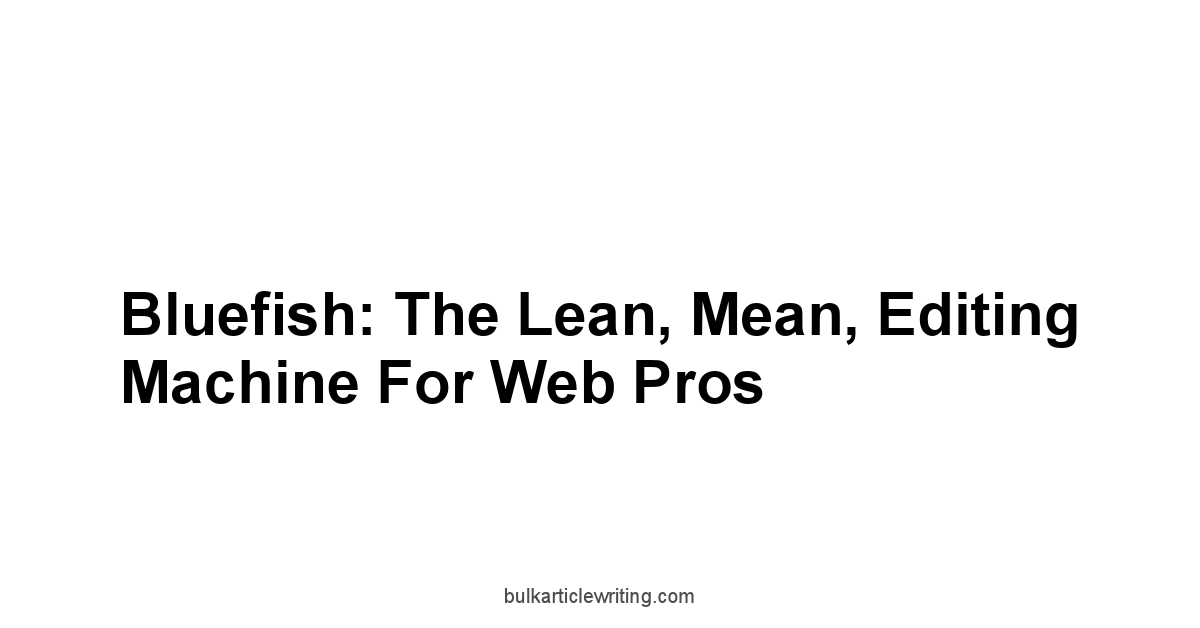The best free HTML editor depends on your needs and experience level, but several strong contenders offer excellent features.
Visual Studio Code, for example, is a popular choice due to its speed, extensive extension library, and powerful IntelliSense autocompletion. Sublime Text, while freemium offering a free trial, provides a fast and elegant interface and is highly customizable via Package Control.
Notepad++, a lightweight and fast option, excels at quick edits and includes robust search and replace functionality, while Atom’s open-source nature and highly hackable interface suit experienced users who prefer extensive customization.
Brackets, from Adobe, offers a unique live preview and inline editors for streamlined front-end development.
Finally, Komodo Edit stands out with its multi-language support and robust code intelligence.
|
0.0 out of 5 stars (based on 0 reviews)
There are no reviews yet. Be the first one to write one. |
Amazon.com:
Check Amazon for Best Html Editor Latest Discussions & Reviews: |
Bluefish, a lightweight powerhouse, prioritizes speed and efficiency for experienced developers.
| Feature | Visual Studio Code | Sublime Text | Notepad++ | Atom | Brackets | Komodo Edit | Bluefish |
|---|---|---|---|---|---|---|---|
| Availability | Free | Freemium free trial | Free | Free open-source | Free open-source | Free | Free |
| Speed | Excellent | Excellent | Excellent | Good | Good | Good | Excellent |
| Customization | Extensive extensions, themes, settings | Extensive Package Control, settings | Moderate plugins | Extensive packages, themes, configuration files | Moderate extensions, themes | Moderate | Moderate settings, macros, snippets |
| Autocompletion | Excellent IntelliSense | Good | Moderate plugins available | Good | Good | Excellent | Moderate plugins available |
| Syntax Highlighting | Excellent | Excellent | Excellent | Excellent | Excellent | Excellent | Excellent |
| Live Preview | No | No | No | No | Yes | No | No |
| Inline Editors | No | No | No | No | Yes | No | No |
| Debugging | Excellent | Good plugins available | Moderate plugins available | Good packages available | Good extensions available | Excellent | Moderate plugins available |
| Git Integration | Excellent | Good plugins available | Moderate plugins available | Excellent | Good extensions available | Good | Moderate plugins available |
| Language Support | Excellent extensions for many languages | Excellent plugins for many languages | Good | Excellent packages for many languages | Good primarily front-end | Excellent many languages | Good |
| Link | https://code.visualstudio.com/ | https://www.sublimetext.com/ | https://notepad-plus-plus.org/ | https://atom.io/ | https://brackets.io/ | https://www.activestate.com/products/komodo-ide/ | https://bluefish.openoffice.org/ |
Read more about Best Html Editor Free
Decoding the Essentials: What Makes an HTML Editor “Best” and “Free”?

This isn’t about flashy features or marketing hype.
We’re dissecting what truly matters in a free HTML editor—the stuff that’ll make you more productive, not just impressed.
Think of this as your cheat sheet to navigating the often-confusing world of code editors, allowing you to pick the right tool for the job without wasting time on fluff.
We’ll be exploring the core features, helping you decide whether a WYSIWYG What You See Is What You Get or code-based editor is your cup of tea, and guiding you through the essential elements to look for before making a commitment. Let’s dive in. Phonak Paradise Comparison Chart
Stripping Back the Hype: Core Features to Look For
Forget the bells and whistles. The foundation of any good HTML editor, free or otherwise, rests on a few key pillars. First and foremost is syntax highlighting. This isn’t just a pretty face. it’s a productivity booster, instantly making your code more readable and easier to debug. Next up is autocompletion, a feature that predicts your code as you type, saving you precious keystrokes and reducing errors. Think of it as your coding superpower. Finally, a good editor should offer customization options, allowing you to tailor the interface, keyboard shortcuts, and other elements to match your unique workflow. Consider these your non-negotiables. Let’s break down each feature with more detail:
-
Syntax Highlighting: Imagine reading a novel without punctuation or paragraph breaks. That’s essentially what coding without syntax highlighting is like. It’s a visual cue that distinguishes different parts of your code keywords, variables, comments, etc., making it easier to spot errors and understand the overall structure. Editors like Visual Studio Code, Sublime Text, and Notepad++ all excel in this department.
-
Autocompletion: This feature, also known as “IntelliSense” in some editors like Visual Studio Code, predicts what you’re going to type based on context. It’s like having a coding assistant that suggests the next line of code before you even think of it. This dramatically speeds up your workflow and reduces the chance of typos or syntax errors. Many free editors, such as Atom and Brackets, include robust autocompletion features.
-
Customization: A great editor is a chameleon, adapting to your preferences rather than forcing you to conform to its limitations. This includes customizable themes to reduce eye strain, keyboard shortcuts to optimize your typing, and extensions to add new features. Sublime Text and Atom are particularly known for their extensive customization capabilities, allowing you to build an editor that feels like an extension of your own mind. Drawing Tool Online
Consider these features your initial checklist when researching free HTML editors. The specifics of implementation might vary, but the core principle remains: ease of use, enhanced productivity, and a workflow tailored to your needs. Let’s look at the next essentials.
WYSIWYG vs. Code: Which Editing Style Suits You?
This is a fundamental choice.
WYSIWYG editors like some online HTML editors let you see the visual representation of your code as you type.
You essentially manipulate the HTML elements directly within a visual interface.
Code editors, on the other hand, present you with a plain text interface where you type the HTML, CSS, and JavaScript directly. Host Website Free
The choice depends largely on your coding experience and project needs.
-
WYSIWYG Advantages: Easier to learn for beginners, immediate visual feedback, intuitive for simple projects. However, they often lack the flexibility and control of code editors.
-
Code Editor Advantages: Greater control over the code, better for complex projects, facilitates learning of HTML and other web development languages, excellent for collaboration through version control systems like Git. However, can have a steeper learning curve.
The vast majority of free HTML editors we’ll discuss are code editors.
These offer the power and flexibility to handle even the most complex web projects. Free Pdf Editor Best
Choosing the right one depends on your familiarity with coding and the complexity of your project.
Let’s delve into the specific elements that can elevate a free HTML editor from adequate to exceptional.
Why Syntax Highlighting is Your New Best Friend
Think of syntax highlighting as the difference between reading a dense, unformatted legal document and a well-structured, easy-to-follow article.
It adds visual cues that differentiate various parts of your code—keywords are in bold, comments are italicized, and strings are colored, making everything much easier to read and comprehend.
This visual clarity directly impacts your productivity by making it easier to spot errors, understand code structure, and write cleaner, more maintainable HTML. Free Hosting Websites
Consider this simple HTML snippet without syntax highlighting:
<p>This is a paragraph.</p> <div>This is a div.</div>
Now, look at the same snippet with syntax highlighting colors may vary depending on your editor:
The difference is immediately apparent.
The highlighted code provides visual separation, reducing cognitive load and allowing for easier reading and comprehension.
Notepad++ is an excellent example of a free editor that excels in syntax highlighting for a wide range of programming languages, including HTML. Edit Pdf Free
Visual Studio Code also offers superb syntax highlighting, customizable to your liking.
Autocompletion: The Productivity Hack You Can’t Ignore
Autocompletion is more than just a convenience—it’s a productivity multiplier.
As you type, the editor suggests relevant code completions, saving you keystrokes and reducing the risk of errors.
This is invaluable when working with long HTML tags or complex CSS selectors, which can easily become tedious to type correctly.
It cuts down on typos, minimizes syntax errors, and frees you to focus on the broader logic of your code. Wat Is Een Juiste Zoekwoorddichtheid
Statistics show that even experienced programmers make errors.
Studies on programmer error rates vary, depending on the complexity of the code and experience level, but generally, studies have reported error rates exceeding 1 error per 100 lines of code.
Even if autocompletion can’t entirely eliminate errors, it significantly reduces their frequency.
Consider the difference between manually typing <div class="container"> and having the editor autocomplete it for you after typing just <div. In the grand scheme of a larger project, these small time savings can add up to significant gains in productivity.
Atom and Brackets, both free and open-source, offer strong autocompletion capabilities. Free Browsers
Komodo Edit also offers this feature, although its focus extends beyond just HTML.
Customization is King: Tailoring Your Editor to Your Workflow
A good editor isn’t a one-size-fits-all solution. It adapts to you, not the other way around.
Customization is paramount, and a good free HTML editor will offer many options for tailoring the interface, keyboard shortcuts, and extensions to perfectly suit your preferences.
Imagine using an editor that slows you down—that’s like a chef using dull knives. it’s counterproductive.
Consider the following customization options: Product Analytics Free
-
Themes: Choose a theme that’s easy on the eyes and minimizes eye strain, especially during long coding sessions. Dark themes are often preferred to reduce glare.
-
Keyboard shortcuts: Learn and customize shortcuts to accelerate your workflow. This is crucial for repetitive tasks such as saving, opening files, and navigating code.
-
Extensions: Expand the core functionality of your editor with extensions, adding support for specific frameworks, linters, and other tools. Visual Studio Code‘s vast extension marketplace is a testament to the power of customization. Sublime Text also leverages a robust plugin ecosystem, enabling a similar degree of customization.
The best free HTML editor for you is the one that seamlessly integrates into your workflow, allowing you to code efficiently and comfortably.
Don’t settle for an editor that feels clunky or restrictive—explore customization options and find the perfect fit. Free Plagiarism Checker Smallseotools
A well-customized editor is an investment in your productivity and overall coding experience.
Visual Studio Code: The Free Powerhouse You Can’t Afford to Miss

VS Code, developed by Microsoft, has swiftly become a favorite among developers worldwide, and for good reason.
It’s free, incredibly versatile, boasts a massive extension library, and offers a level of customization that’s hard to beat.
Its speed, integrated terminal, and intuitive interface make it an exceptionally powerful choice, even for complex projects. This isn’t just another editor. Title Tag Optimaliseren
It’s a whole ecosystem tailored to boost your productivity.
Diving into VS Code’s Killer Features
VS Code shines due to a combination of factors, starting with its blazing speed. This isn’t just marketing.
Large files and complex projects load quickly, ensuring a smooth, responsive experience.
The integrated terminal is a must, eliminating the need to switch between your editor and command prompt.
You can run scripts, manage your projects, and debug directly within VS Code. Small Seo Tools Plagiarism Checker Free Download
Moreover, the IntelliSense autocompletion feature is remarkably accurate, learning from your codebase and offering context-relevant suggestions.
This is a huge timesaver, especially for repetitive coding tasks.
-
Speed and Responsiveness: VS Code is known for its speed, even when handling massive files or projects. This contributes to a smoother, less frustrating development experience, enhancing your overall productivity.
-
Integrated Terminal: The built-in terminal eliminates the need to constantly switch between your editor and your command-line interface, optimizing your workflow.
-
IntelliSense Autocompletion: VS Code’s IntelliSense isn’t just an autocompletion tool. it’s a smart assistant, understanding the context of your code and providing highly relevant suggestions. Best Free Password Manager Chrome
-
Git Integration: VS Code has seamless Git integration, simplifying version control and streamlining collaborative efforts.
Extensions Galore: Leveling Up Your VS Code Game
VS Code’s strength lies partly in its vast library of extensions.
This is a curated collection of community-created add-ons that can significantly enhance the editor’s functionality.
Need support for a specific framework? There’s an extension for that.
Want to improve your debugging workflow? There’s an extension for that too. Seo Plagiarism Check
This extensibility elevates VS Code from a merely capable code editor to a fully customizable development environment tailored precisely to your needs.
Think of extensions as power-ups for your coding experience.
Here’s a snapshot of what extensions can offer:
-
Linting and Code Formatting: Automatically check your code for errors and style inconsistencies, ensuring cleaner, more maintainable code.
-
Debugging Tools: Enhance your debugging workflow with visual tools that aid in finding and fixing errors. Pdf Editor
-
Support for Specific Frameworks and Languages: Extend support for popular frameworks like React, Angular, or Vue.js.
-
Theme Customization: Personalize the visual appearance of the editor with a wide range of themes to suit your preference.
The sheer volume and quality of extensions offered in the VS Code marketplace solidify its position as a leading free HTML editor.
Visual Studio Code empowers you to tailor your development environment exactly as you need it, making it a highly adaptable tool for diverse projects.
Mastering VS Code’s Integrated Terminal
The integrated terminal in VS Code is a hidden gem that significantly streamlines your workflow.
It eliminates the need for constantly switching between your code editor and the command line.
This alone can save significant time and increase your coding efficiency.
You can manage your project files, run commands, debug code, and execute scripts directly within the VS Code window, keeping everything in one central location.
-
Command-Line Access: Directly execute shell commands within VS Code, eliminating context switching and improving efficiency.
-
Task Running: Define and run custom tasks, such as building projects or running tests, directly from within VS Code.
-
Debugging: Leverage the integrated terminal for debugging purposes, eliminating the need for a separate debugging interface.
-
Collaboration: The integrated terminal simplifies collaborative coding by enabling seamless access to version control systems and shared resources.
The integrated terminal, coupled with other features, makes Visual Studio Code a powerful and versatile choice.
Mastering its use is key to maximizing your productivity.
Real-World Use Cases: Where VS Code Shines
VS Code’s versatility is evident in its broad range of applications. It’s not just for HTML.
Its strength lies in its adaptability across multiple programming languages and web development tasks.
Here are some scenarios where VS Code stands out:
-
Front-End Development: HTML, CSS, JavaScript, React, Angular, Vue.js – VS Code excels in all these areas, providing robust support and extensions for each.
-
Back-End Development: While not its primary focus, VS Code can handle back-end development with extensions that support Node.js, Python, and other server-side languages. You can often manage both front-end and back-end components within the same workspace.
-
Data Science: With extensions supporting Python libraries like Pandas and scikit-learn, VS Code is becoming a popular choice for data science tasks.
-
Cloud Development: Extensions supporting cloud platforms like Azure and AWS further enhance VS Code’s reach and make it suitable for cloud-based projects.
VS Code has a place in almost any coding scenario, showcasing its flexibility and power.
Its adaptability to various programming languages makes it a top contender for most developers.
This comprehensive feature set establishes Visual Studio Code as a free editor that can power your entire development workflow.
Sublime Text: Free to Try, Worth the Splurge?

Sublime Text is a veteran in the code editor arena, known for its speed, elegance, and powerful features.
While it’s technically a freemium model free to try, paid for full functionality, its free version provides enough to make it worth considering, particularly if you prioritize speed and a clean interface. This is a minimalist’s dream.
Why Developers Swear By Sublime’s Speed and Efficiency
Sublime Text’s speed is legendary.
It’s incredibly fast and responsive, even when handling large files or complex projects.
This responsiveness is critical for maintaining focus and reducing the frustration that comes with laggy editors.
The interface is clean and uncluttered, minimizing distractions and promoting focus.
This minimalist approach is a boon to productivity.
-
Blazing Speed: Sublime Text’s speed is one of its most compelling features, providing a smooth, responsive experience regardless of project size.
-
Minimalist Interface: The clean, uncluttered interface minimizes distractions and promotes focus, enhancing coding efficiency.
-
Multiple Selections: Sublime Text allows for multiple selections, enabling efficient editing of multiple lines of code simultaneously.
-
Command Palette: Quickly access commands and features using the powerful command palette, streamlining your workflow.
Package Control: Your Gateway to Sublime Text Superpowers
Sublime Text’s Package Control is a must-have plugin that unlocks its full potential.
It’s a package manager that makes it incredibly easy to install and manage various plugins extensions. These plugins expand the editor’s functionality, from adding support for new languages to enhancing its code completion capabilities.
Consider Package Control as the key that opens the door to Sublime Text’s extensive ecosystem of add-ons.
Here are some highly-rated plugins available through Package Control:
-
Emmet: Emmet is a productivity tool for web developers that allows you to write HTML and CSS much faster, thanks to its abbreviations.
-
BracketHighlighter: BracketHighlighter helps visualize matching brackets and braces in code, reducing errors.
-
SublimeLinter: SublimeLinter helps improve code quality by identifying potential errors and style inconsistencies.
-
GitGutter: GitGutter shows Git changes directly within the editor, streamlining the version control process.
Customizing Sublime Text for Maximum Productivity
While Sublime Text’s default settings are already optimized for efficiency, the ability to customize it further solidifies its position as a productivity powerhouse.
Keybindings, themes, and plugins offer incredible flexibility, allowing you to adapt the editor to your unique preferences and workflow.
Think of it as sculpting your perfect coding environment.
Here’s how to maximize Sublime Text’s customization:
-
Key Bindings: Customize keybindings to fit your preferred workflow, optimizing your speed and reducing repetitive actions.
-
Color Schemes: Choose a color scheme that minimizes eye strain and enhances readability.
-
Distraction-Free Mode: Engage distraction-free mode for immersive coding sessions.
-
Snippets: Create snippets for commonly used code blocks, saving time and effort.
Sublime Text provides an impressive level of control, allowing experienced programmers to hone the interface to their precise needs.
Sublime Text’s Distraction-Free Mode: Focus on What Matters
Sublime Text’s distraction-free mode is a must for those who need to focus deeply on their code.
This mode essentially removes all clutter from the interface, leaving only your code.
It’s perfect for those times when you need maximum concentration.
This minimalist approach is surprisingly effective in enhancing your focus and productivity.
-
Enhanced Focus: Distraction-free mode eliminates unnecessary interface elements, allowing you to focus solely on the code.
-
Improved Concentration: Studies show that minimal distractions can significantly enhance concentration, which is vital for successful coding.
-
Reduced Cognitive Load: By limiting the visual information, distraction-free mode minimizes cognitive overload, allowing for more efficient code writing.
-
Optimized Workflow: The streamlined interface boosts workflow efficiency, particularly beneficial for complex or long coding sessions.
Sublime Text’s features, especially its distraction-free mode, make it a valuable option for experienced programmers who prioritize focus and efficiency.
Combined with Package Control, Sublime Text provides a powerful and customizable environment for coding, making it a strong competitor in the HTML editor space.
Notepad++: The Lightweight Champion That Refuses to Quit

Notepad++ is a veteran in the text editor world, revered for its simplicity, lightweight design, and surprising power.
While it may lack some of the bells and whistles of more modern editors, its speed, plugin support, and robust search functionality make it an excellent choice, especially for those who value speed and efficiency.
Think of it as the trusty workhorse of the code editor family.
Why Notepad++ Remains a Staple for Quick Edits
Notepad++’s primary strength is its speed.
It’s incredibly fast and responsive, even on older machines or with large files.
This makes it ideal for quick edits or tasks that don’t require the full suite of features found in more bloated editors.
Its simplicity is also a significant advantage, offering a clean, distraction-free environment for coding.
-
Lightweight Design: Notepad++’s small footprint makes it exceptionally fast and responsive, even on less powerful machines.
-
Simplicity and Efficiency: Its clean, uncluttered interface allows for quick and efficient coding.
-
Wide Language Support: Notepad++ supports a broad range of programming languages, not just HTML.
-
Extensive Plugin Support: The vast range of plugins further extends Notepad++’s functionality, adding features for specific needs.
Essential Plugins for Transforming Notepad++
While Notepad++ is powerful on its own, plugins can significantly expand its capabilities.
The Plugin Manager simplifies the installation process, providing access to a vast library of extensions.
These extensions add features such as code completion, syntax highlighting for additional languages, and improved debugging tools.
Key plugins to consider include:
-
NppFTP: Allows you to easily manage files on remote servers via FTP.
-
Compare Plugin: Enables side-by-side comparison of files.
-
AutoCompletion: Enhances the editor’s autocompletion capabilities.
-
HTML Tag: A helpful tool for HTML coding and formatting.
These plugins effectively transform Notepad++, extending its versatility and usefulness beyond its core functionality.
Mastering Notepad++’s Search and Replace Functionality
Notepad++’s search and replace functionality is remarkably powerful.
It goes beyond simple text searches, offering advanced options like regular expressions, allowing you to perform complex search and replace operations efficiently.
This feature is surprisingly effective in speeding up repetitive tasks or dealing with large codebases.
-
Regular Expressions Support: The powerful regular expression support makes complex search-and-replace operations feasible.
-
Multi-Line Searches: Search across multiple lines of code simultaneously for comprehensive results.
-
Case Sensitivity: Fine-tune searches by specifying case sensitivity.
-
Whole Word Matching: Ensure your searches target entire words, avoiding partial matches.
Mastering Notepad++’s search and replace capabilities is key to maximizing its efficiency in your daily work.
This functionality can save significant time on otherwise laborious tasks.
Notepad++ as a Go-To Text Editor: Simplicity at Its Finest
Notepad++ provides a balance of simplicity and power.
Its lightweight design makes it incredibly fast, and its robust search functionality is quite impressive.
It’s an excellent option for those who prefer a minimalist approach and a fast, responsive editor.
However, it does lack some of the advanced features and extensibility of more modern editors like VS Code.
Nevertheless, its simplicity and speed make it a compelling alternative for specific coding tasks.
While it might not be suitable for extremely large projects, Notepad++ remains a practical and efficient editor for quick edits and smaller projects.
Atom: The Hackable Editor That’s Open to Anything

Atom is a free, open-source editor that prides itself on its extreme customization.
Developed by GitHub, it’s a highly hackable tool that lets you tailor almost every aspect of the interface and functionality.
This level of control makes it incredibly versatile, but it can also have a steeper learning curve than some of the more streamlined editors.
Understanding Atom’s Core Customization Capabilities
Atom’s philosophy centers around customization.
It’s built on web technologies HTML, CSS, and JavaScript, meaning you can deeply modify the appearance and behavior of the editor.
This provides unmatched flexibility, but it also means the learning curve is somewhat steeper than other editors.
You are effectively controlling the user interface with code.
-
Themes: Atom has a vast library of themes, each offering a different visual style, allowing you to select an interface that suits your preference.
-
Packages: Atom’s package manager provides access to thousands of extensions that expand the editor’s functionality.
-
Key Bindings: Customizable key bindings allow you to adjust keyboard shortcuts to match your preferences, optimizing efficiency.
-
Configuration Files: Atom allows granular control through configuration files, enabling highly customized settings and behaviors.
Community Packages: Extending Atom’s Functionality
Atom’s open-source nature fosters a thriving community that contributes a vast array of packages extensions. These packages add new functionality, improve existing features, and enhance the editor’s overall capability.
The community support is a significant advantage, ensuring a continuous stream of updates and improvements.
-
Language Support: Packages add support for various programming languages, making Atom versatile for various coding projects.
-
Code Completion: Enhance Atom’s autocompletion capabilities with specialized packages.
-
Linters and Formatters: Improve code quality by automatically checking code for errors and style inconsistencies.
-
UI Enhancements: Packages can refine the user interface, further improving the coding experience.
Atom’s Built-in Package Manager: A Deep Dive
Atom’s built-in package manager is a powerful tool that simplifies the process of installing, updating, and managing extensions.
It’s user-friendly, providing a clear interface for searching and installing new packages.
This greatly simplifies the customization process.
-
Easy Installation: The package manager makes it simple to install new packages with a few clicks.
-
Update Management: Easily manage updates to ensure that you are using the latest versions of the packages.
-
Dependency Management: Handles dependencies between packages, ensuring smooth operation.
-
Search and Discovery: Provides a search function to easily discover new packages.
Atom vs. VS Code: Which Open-Source Editor Wins?
Atom and VS Code are both powerful, open-source editors with extensive customization capabilities. However, there are some key differences:
-
Speed: VS Code generally performs faster, particularly with larger projects.
-
Extensibility: Both have large extension libraries, but VS Code’s market might be slightly larger and more mature.
-
Learning Curve: Atom’s steep learning curve might make it less accessible to beginners compared to the more user-friendly VS Code.
While both are excellent choices, Visual Studio Code generally edges out Atom due to its speed and slightly easier learning curve.
However, Atom’s deep customization capabilities remain a compelling argument for those who demand absolute control.
Brackets: Adobe’s Free Gift to Web Developers

Brackets is a free, open-source HTML editor developed by Adobe, designed specifically for web developers.
It focuses on providing a streamlined, intuitive experience, particularly for front-end tasks like HTML, CSS, and JavaScript development.
While not as widely used as VS Code or Sublime Text, Brackets has some unique features that make it worth considering.
Unpacking Brackets’ Unique Live Preview Feature
Brackets’ live preview is its standout feature, offering a dynamic preview of your HTML, CSS, and JavaScript code within a web browser.
Changes you make in the editor are immediately reflected in the browser, enabling rapid iteration and testing.
This significantly streamlines the development process.
-
Immediate Feedback: See changes reflected in real-time without manual refresh, providing immediate feedback during development.
-
Rapid Iteration: Quickly experiment with design and functionality changes, accelerating the development cycle.
-
Simplified Debugging: Easily identify and resolve errors by observing real-time changes in the preview.
-
Enhanced Workflow: The live preview integrates the development process, improving efficiency.
Inline Editors: A Game-Changer for CSS and JavaScript
Brackets’ inline editors provide a powerful way to directly edit the CSS and JavaScript code associated with HTML elements.
When you select an element in the live preview, the associated CSS and JavaScript code becomes instantly editable within the editor.
This provides a seamless workflow when working with styles or behaviors linked to specific elements.
-
Targeted Editing: Directly edit CSS or JavaScript that applies to a selected HTML element.
-
Improved Context Awareness: Keep track of code relationships between HTML, CSS, and JavaScript elements for better organization.
-
Streamlined Workflow: Combine editing and viewing for a dynamic, responsive workflow.
-
Reduced Errors: Improve accuracy by maintaining a visual link between code and effect.
Extensions and Themes: Making Brackets Your Own
While not as extensive as VS Code’s, Brackets does have a range of extensions and themes to expand its capabilities and customize the appearance.
This enables you to tailor the editor to match your preferences.
-
Improved Functionality: Enhancements through extensions include linters, debugging tools, and integration with other software.
-
Visual Appeal: Themes customize the editor’s appearance, ranging from dark modes to more colorful designs.
-
Community Contributions: Extensions and themes are community-supported, demonstrating ongoing development and improvements.
-
Personalized Workflow: Customization allows you to adjust Brackets to fit your personal workflow and preferences.
How Brackets Simplifies Front-End Development
Brackets is tailored for front-end development, focusing on streamlining the process of creating and testing websites.
Its live preview and inline editors are particularly beneficial for front-end developers.
-
Efficient Workflow: The combination of live preview and inline editors makes front-end development more intuitive and efficient.
-
Real-Time Feedback: Immediately see the results of your changes, speeding up development and debugging.
-
Targeted Adjustments: Easily make precise adjustments to CSS or JavaScript without disrupting other parts of the code.
-
Improved Productivity: Ultimately, Brackets’ features combine to improve the overall productivity for front-end development tasks.
Brackets remains a viable option, particularly for those who value its specialized features geared towards front-end development.
While not as feature-rich as VS Code, its tailored approach offers a unique advantage for specific users.
Komodo Edit: The Multi-Language Maestro You Need to Know

Komodo Edit is a powerful, free multi-language code editor that stands out for its support of numerous programming languages and its robust code intelligence features.
This makes it a versatile option for those working on projects that involve multiple languages, exceeding the typical HTML-focused editors.
Exploring Komodo Edit’s Language Support
Komodo Edit’s greatest strength lies in its wide language support, extending well beyond HTML, CSS, and JavaScript.
It provides robust support for numerous languages, including Python, PHP, Ruby, Perl, and many more.
This makes it particularly appealing to those involved in projects with diverse codebases.
-
HTML, CSS, and JavaScript: Strong support for the fundamental web development languages.
-
Back-End Languages: Comprehensive support for languages like Python, PHP, Ruby, and Perl.
-
Other Languages: Support for a broad range of other languages, increasing its versatility.
-
Cross-Platform Compatibility: Komodo Edit works on Windows, macOS, and Linux, ensuring accessibility across various systems.
Code Intelligence: Boosting Your Coding Efficiency
Komodo Edit’s code intelligence features dramatically boost productivity.
It provides features like code completion, syntax highlighting, and intelligent code suggestions that adapt to the language you’re working with.
This smart assistance reduces coding errors and accelerates your workflow.
-
Code Completion: Automatically suggest relevant code snippets as you type, minimizing typos and speeding up development.
-
Syntax Highlighting: Clearly distinguishes different code elements, enhancing readability and reducing errors.
-
Smart Suggestions: Offers code suggestions tailored to the context of your code.
-
Refactoring Tools: Assist with code refactoring, improving the structure and maintainability of your projects.
Komodo Edit’s Debugging Capabilities: Catching Bugs Faster
Komodo Edit also features debugging capabilities, making it simpler to identify and resolve errors in your code.
These debugging tools can save you significant time and effort, speeding up the development process.
-
Breakpoint Setting: Set breakpoints in your code to pause execution at specific points for inspection.
-
Variable Inspection: Examine the values of variables at runtime.
-
Step-Through Execution: Step through your code line-by-line to observe execution flow.
-
Call Stack Analysis: Understand the sequence of function calls.
Komodo Edit vs. Other Multi-Language Editors: What Sets It Apart?
Komodo Edit stands out from other multi-language editors due to its combination of features.
While other editors offer strong language support or code intelligence, Komodo Edit effectively combines these elements with debugging capabilities, resulting in a powerful and versatile tool.
-
Comprehensive Feature Set: Combines strong language support, code intelligence, and debugging capabilities into a cohesive package.
-
Integrated Development Environment: Provides a comprehensive development environment with all essential tools in one location.
-
Adaptability: Handles a wide range of programming languages, making it suitable for diverse projects.
-
Active Development: Komodo Edit receives regular updates, ensuring continuous improvements.
Komodo Edit offers a robust, all-in-one solution for developers working across multiple languages.
While it might not be the most well-known, its capabilities make it a valuable asset for those whose needs extend beyond the typical HTML-centric development workflow.
Bluefish: The Lean, Mean, Editing Machine for Web Pros

Bluefish is a lightweight, fast, and surprisingly powerful HTML editor designed for web developers.
While it may not be as visually appealing or feature-rich as some modern editors, its speed and efficiency make it a strong contender for those who prioritize performance. Its focus is raw speed and efficiency.
The Power of Bluefish’s Lightweight Design
Bluefish’s primary selling point is its lightweight design.
It’s remarkably fast and responsive, even on less powerful machines or with very large files.
This makes it ideal for situations where speed and responsiveness are paramount.
-
Quick Startup: Starts up quickly, minimizing the time you spend waiting for your editor to load.
-
Rapid Performance: Handles large files and complex projects efficiently, maintaining responsiveness.
-
Low Resource Consumption: Requires minimal system resources, ensuring a stable workflow even on older machines.
-
Optimized for Speed: Designed with speed and efficiency in mind, improving your overall productivity.
Diving into Bluefish’s Advanced Search and Replace
Bluefish boasts a robust search and replace functionality, including support for regular expressions.
This makes it easy to perform complex searches and replacements across multiple files, greatly increasing coding efficiency.
-
Regular Expression Support: Advanced searching and replacing capabilities using regular expressions.
-
File Searching: Search across multiple files simultaneously for efficient project-wide changes.
-
Multiple Replacements: Perform multiple replacements in a single operation for rapid bulk modifications.
-
Enhanced Accuracy: Precisely target and modify code, reducing the risk of errors.
Bluefish’s Snippets and Macros: Automating Repetitive Tasks
Bluefish allows you to define and use code snippets and macros to automate repetitive tasks.
This automation significantly reduces the amount of manual typing and helps improve coding speed and consistency.
-
Time Savings: Reduce the time spent on repetitive tasks by automating them with snippets and macros.
-
Consistency: Ensure consistency in your codebase by using predefined snippets.
-
Customizable Shortcuts: Assign custom shortcuts to snippets and macros for improved workflow efficiency.
-
Productivity Boost: Overall, snippets and macros provide a substantial productivity boost.
Bluefish: The Best Choice for Experienced Coders?
Bluefish may not be the most user-friendly choice for beginners due to its minimalist interface.
However, its power and speed make it highly appealing to experienced coders who value performance above all else.
Its focus on efficiency and its advanced features, such as powerful search and replace and snippet functionality, are attractive to users who are comfortable with advanced tools.
-
Fast and Efficient: Ideal for experienced developers prioritizing speed and efficiency over a visually rich interface.
-
Powerful Features: Offers robust features such as advanced search and replace and snippet management.
-
Customization Options: While less visually customizable than other editors, Bluefish offers extensive options to refine functionality.
-
Mature Editor: Bluefish has been around for years and benefits from a mature codebase with strong functionality.
Bluefish occupies a niche, serving those prioritizing raw speed and efficiency.
For experienced users familiar with powerful text editors, it provides a lean and mean coding experience that is hard to beat in terms of performance.
Frequently Asked Questions
What are the absolute must-have features in any free HTML editor?
Based on the essential criteria, the core features you absolutely need in a free HTML editor are syntax highlighting, autocompletion, and good customization options. These aren’t just nice-to-haves.
They are foundational elements that directly impact your productivity and the ease of spotting errors, making your coding life much smoother. Think of them as the bedrock.
Editors like Visual Studio Code and Sublime Text build upon these essentials.
Is syntax highlighting truly essential or just a cosmetic addition?
No, syntax highlighting is definitely not just cosmetic. it’s a productivity booster.
It provides visual cues, like different colors or styles for keywords, variables, and comments, making your code dramatically more readable.
This clarity helps you understand the code structure more easily and makes it quicker to spot typos or syntax errors.
Notepad++ is an example of a free editor that does an excellent job with syntax highlighting across various languages, including HTML.
How does autocompletion actually save you time when coding?
Autocompletion saves you time by predicting the code you’re likely to type as you’re writing, based on context.
It suggests completions for tags, attributes, and other elements, significantly reducing the number of keystrokes needed.
This speeds up your typing and minimizes the chance of introducing simple typos or syntax errors.
It’s like having a helpful assistant anticipating your next move.
Editors such as Atom and Brackets offer robust autocompletion features.
Why is customizing your editor’s interface and shortcuts a big deal for productivity?
Customization is key because it allows you to tailor the editor to your specific workflow and preferences.
This includes changing themes to reduce eye strain, setting up keyboard shortcuts that feel natural to you, and adding extensions to fit your needs.
When an editor adapts to you, rather than the other way around, you become more efficient and comfortable.
Sublime Text and Atom are particularly strong in offering extensive customization.
What’s the fundamental difference between a WYSIWYG and a code-based HTML editor?
The fundamental difference lies in how you interact with the code.
A WYSIWYG What You See Is What You Get editor provides a visual interface where you manipulate elements directly and see the resulting layout in real-time, often without needing to look at the underlying code initially.
A code editor, conversely, presents a plain text interface where you write and edit the raw HTML, CSS, and JavaScript code directly.
The vast majority of powerful free HTML editors, like Visual Studio Code, fall into the code editor category.
For serious web development, is a code editor generally the better choice?
Yes, for serious and complex web development projects, a code editor is generally the better choice.
While WYSIWYG editors can be easier for beginners or simple tasks, code editors offer much greater control over the code itself.
They are better suited for complex projects, help you truly learn the underlying languages, and facilitate collaboration through version control systems.
Editors like Visual Studio Code and Sublime Text provide the power and flexibility needed for professional work.
Which free editors are mentioned as having great syntax highlighting?
Based on the details, several free editors are highlighted for their excellent syntax highlighting capabilities.
These include Visual Studio Code, Sublime Text, and Notepad++. Syntax highlighting in these editors makes the code visually distinct, improving readability and making it easier to catch errors quickly.
Can autocompletion help reduce the number of typos in your code?
Yes, absolutely.
Autocompletion is designed specifically to help reduce typos and syntax errors.
By suggesting and completing code elements as you type, it minimizes the need for manual input of potentially long or complex code snippets, which are common sources of errors.
This feature in editors like Atom and Brackets significantly boosts accuracy and speed.
Which free editors are highlighted for their strong autocompletion features?
Several free editors are noted for having robust autocompletion capabilities.
Visual Studio Code‘s feature, known as “IntelliSense,” is highlighted as being particularly accurate and context-aware.
Additionally, Atom, Brackets, and Komodo Edit are also mentioned as including strong autocompletion functionality, saving you time and reducing errors.
Is it possible to change the visual theme of a free HTML editor to reduce eye strain?
Yes, most good free HTML editors offer the ability to change themes.
Customizable themes are a key aspect of editor customization, allowing you to choose color schemes and visual styles that are easier on your eyes, especially during long coding sessions.
Dark themes, for instance, are often preferred to reduce glare and minimize eye fatigue.
Editors like Visual Studio Code and Sublime Text provide extensive theme options.
Is really free to use?
Yes, Visual Studio Code, often called VS Code, is completely free to download and use.
It’s developed by Microsoft and has gained massive popularity due to its robust feature set, speed, and extensive customization options available through its large extension marketplace, all without a cost barrier.
What key features make such a popular choice?
Visual Studio Code‘s popularity stems from a combination of powerful features.
It’s known for its blazing speed, integrated terminal eliminating the need to switch windows, intelligent autocompletion IntelliSense, seamless Git integration for version control, and perhaps most significantly, its vast library of extensions that allow you to tailor it for almost any task or language.
How does the integrated terminal in improve workflow?
The integrated terminal in Visual Studio Code significantly improves workflow by allowing you to execute command-line tasks directly within the editor window.
This means you don’t have to constantly switch between your code editor and a separate terminal application to run scripts, manage files, use Git, or debug, keeping everything you need in one place for a smoother process.
Is “IntelliSense” in just another name for autocompletion?
Yes, in the context of Visual Studio Code, “IntelliSense” is essentially a more intelligent and context-aware form of autocompletion.
It goes beyond simple word completion, understanding the structure of your code to provide highly relevant suggestions for functions, variables, and other elements, making coding faster and reducing errors.
How important are extensions for getting the most out of ?
Extensions are extremely important for maximizing the capabilities of Visual Studio Code. They provide a way to add support for new programming languages, integrate linters and formatters, enhance debugging tools, and customize themes and keybindings.
The extensive extension marketplace transforms VS Code from a great editor into a highly personalized development environment tailored to your specific needs and projects.
Can be used for back-end development or only front-end?
No, Visual Studio Code is not limited to just front-end development.
While it excels in areas like HTML, CSS, and JavaScript, its versatility and extensive extension ecosystem mean it can easily be used for back-end development as well, with robust support available for languages like Node.js, Python, PHP, and more.
Is completely free, or does it have limitations?
Sublime Text is technically a freemium editor.
It’s free to download and try indefinitely, offering full functionality in the trial version.
However, it will occasionally prompt you to purchase a license.
While it doesn’t block features or have a time limit on its free use, it’s not strictly “free” in the same sense as open-source options like Visual Studio Code or Atom as it requires a paid license for continued, non-nag use.
What is particularly known for, and why does it matter?
Sublime Text is particularly known for its exceptional speed, minimalist interface, and powerful features like multiple selections and a command palette.
Its speed and responsiveness are crucial for maintaining focus, especially when working with large files.
The clean interface minimizes distractions, and features like multiple selections allow for highly efficient editing, saving significant time on repetitive tasks.
What is Package Control in and why is it important?
Package Control is a crucial community-developed package manager for Sublime Text. It simplifies the process of installing, upgrading, and removing the many plugins available for the editor.
Package Control is important because it’s the primary way to extend Sublime Text’s functionality, adding support for new languages, productivity tools like Emmet, and other enhancements that tailor the editor to your needs.
Does offer features to help you focus, like a distraction-free mode?
Yes, Sublime Text includes a powerful distraction-free mode.
When activated, this mode clears away all interface elements except your code, allowing for maximum focus and concentration.
This minimalist view is highly effective for deep coding sessions where minimizing visual clutter is a priority for productivity.
Is only good for basic text editing, or can it handle HTML effectively?
No, Notepad++ is much more than just a basic text editor.
It can handle HTML effectively and is a widely used tool for coding.
While simple and lightweight, it offers robust features like syntax highlighting for HTML and many other languages, plugin support for extended functionality, and a powerful search and replace engine, making it a very capable editor for web development tasks, especially quick edits and smaller projects.
What is the main advantage of using a lightweight editor like ?
The main advantage of using a lightweight editor like Notepad++ is its speed and low system resource consumption.
It starts up almost instantly and remains fast and responsive even when opening large files or running on older hardware.
This makes it incredibly efficient for quick edits and ensures a smooth coding experience without lag.
Can you add extra features to using plugins?
Yes, you can significantly extend the capabilities of Notepad++ by using plugins.
Notepad++ has a dedicated Plugin Manager that provides access to a wide library of community-contributed extensions.
These plugins can add features like FTP capabilities NppFTP, file comparison, enhanced autocompletion, and various tools tailored for specific programming tasks.
How powerful is ‘s search and replace function?
Notepad++‘s search and replace function is surprisingly powerful, extending well beyond simple text matching.
It includes support for regular expressions, which allows you to perform complex pattern-based searches and replacements across single or multiple files.
This advanced functionality is a key feature that makes Notepad++ highly efficient for manipulating large codebases or performing intricate text transformations.
What does it mean that is a “hackable” editor?
When it’s said that Atom is a “hackable” editor, it means it’s built on web technologies HTML, CSS, and JavaScript and is designed to be highly customizable from the ground up.
Users can deeply modify almost every aspect of the editor’s interface, features, and behavior by writing code or installing community-developed packages.
This offers unparalleled flexibility for those who want complete control over their coding environment.
Since is open-source, does it rely heavily on community contributions?
Yes, since Atom is an open-source project developed by GitHub, it relies heavily on contributions from its community.
The vast library of packages extensions available for Atom are largely community-created and maintained, which significantly enhances its functionality and adaptability.
This community involvement is a major strength for Atom, ensuring a continuous stream of new features and improvements.
How does ‘s learning curve compare to other popular free editors?
Atom‘s learning curve can be somewhat steeper compared to more streamlined editors like Visual Studio Code or Notepad++, primarily because of its deep customization capabilities.
While its basic usage is straightforward, truly leveraging its “hackable” nature and exploring the extensive package ecosystem to tailor it perfectly can take more time and effort compared to editors with a more fixed feature set.
What is the standout, unique feature of ?
The standout and most unique feature of Brackets is its Live Preview functionality.
This feature provides a real-time preview of your HTML, CSS, and JavaScript code in a web browser that updates instantaneously as you make changes in the editor.
This direct, immediate visual feedback significantly speeds up front-end development and testing cycles.
How do inline editors in help streamline front-end development?
Inline editors in Brackets streamline front-end development by allowing you to edit CSS or JavaScript code directly in context with the related HTML element.
When you select an HTML element in the editor, you can press a shortcut to reveal and edit the associated CSS rules or JavaScript code right there, without needing to open a separate file.
This keeps related code together visually and enhances the workflow for styling and scripting specific page elements.
Is only for HTML, or does it support multiple programming languages?
No, Komodo Edit is explicitly designed as a multi-language code editor.
While it provides strong support for HTML, CSS, and JavaScript, its strength lies in its extensive support for numerous other programming languages, including Python, PHP, Ruby, Perl, and many more.
This makes it a highly versatile tool for developers working on projects that involve diverse codebases or different technologies, setting it apart from editors focused primarily on web languages.


Leave a Reply